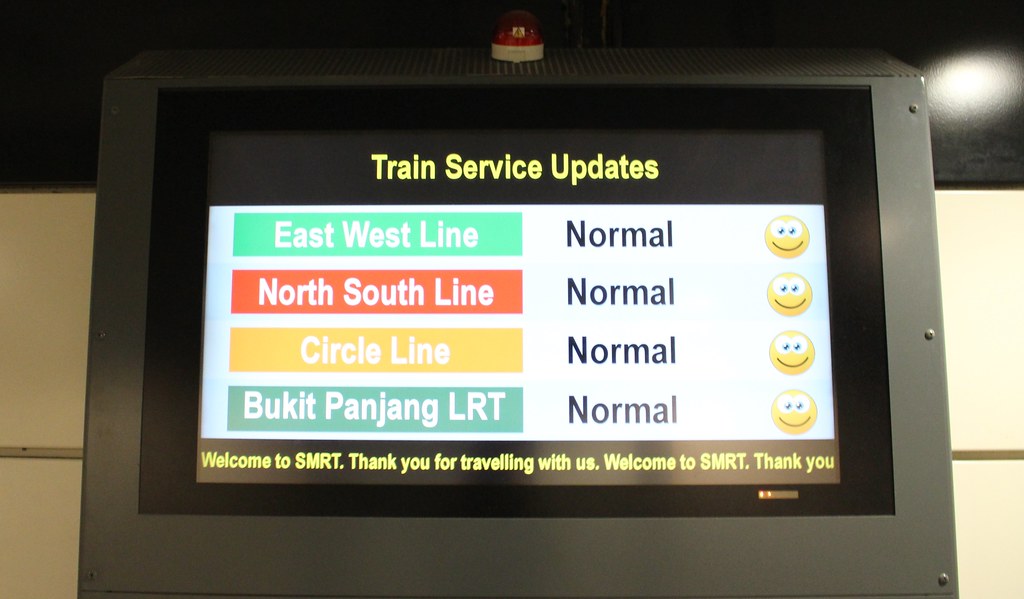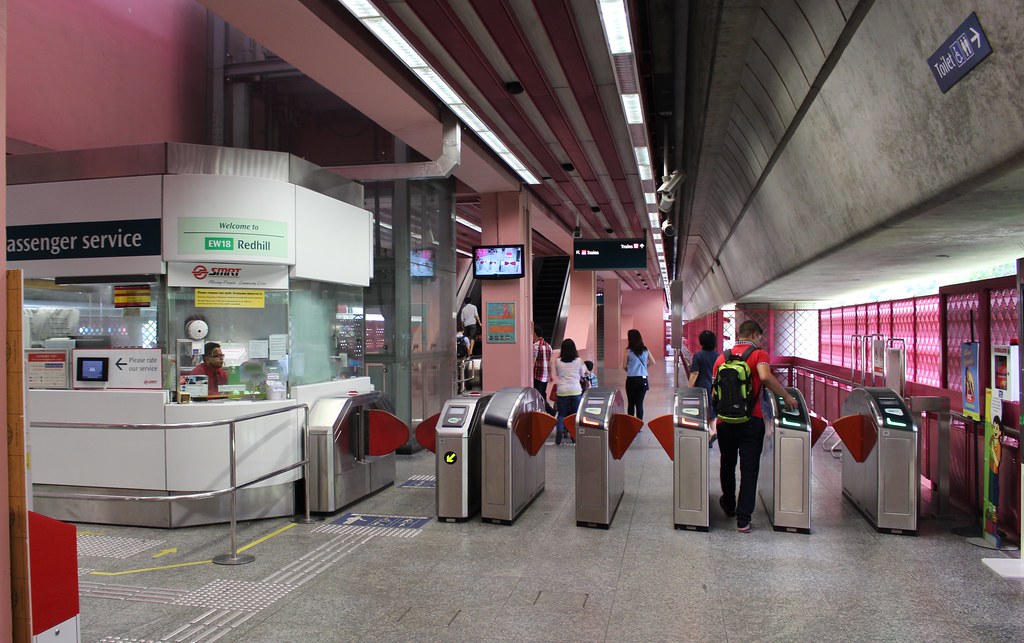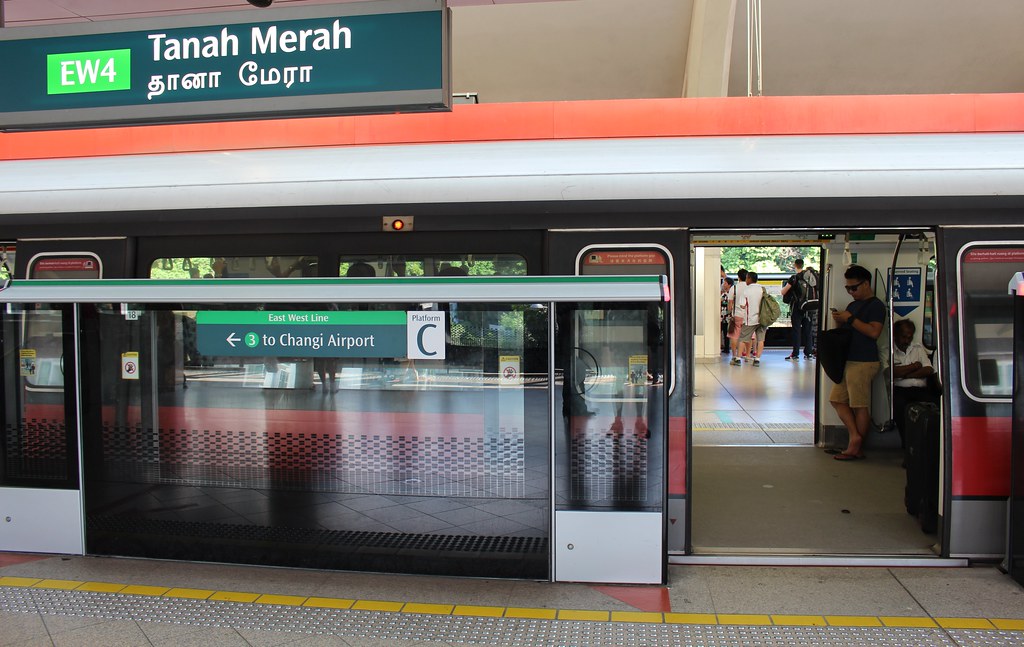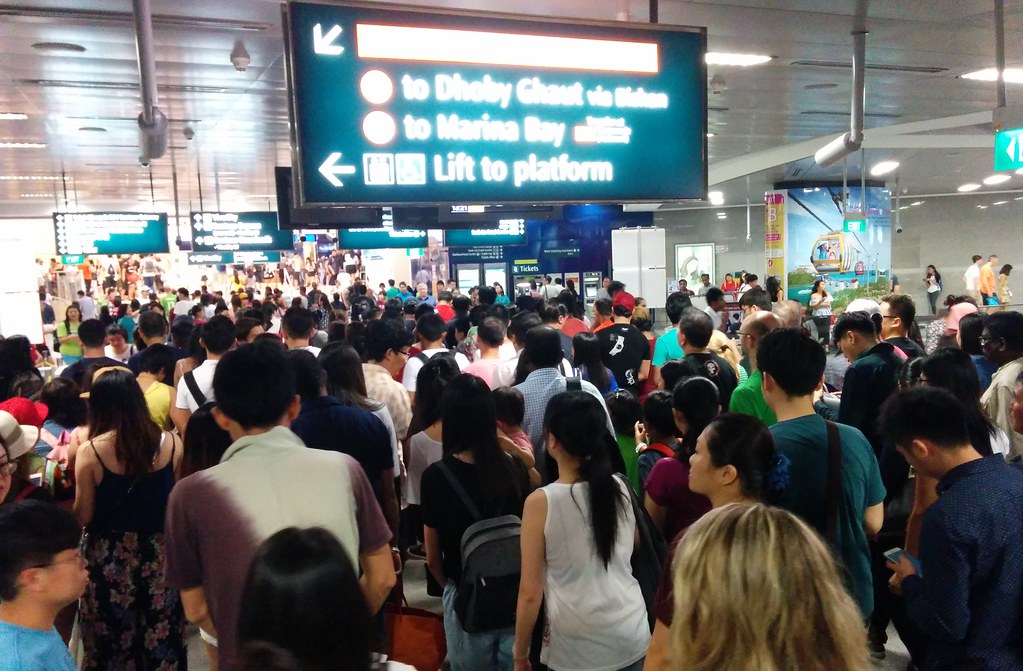See also: my other posts from Singapore
This post pulls together some things I saw on my on my holiday, together with information gleaned from a briefing with the Singapore Land Transport Authority (organised by chance courtesy of the Victorian Government when some of their people discovered they’d be in Singapore at the same time I was), together with information trawled off the web.
MRT and Metro
Singapore: MRT stands for Mass Rapid Transit. It’s Singapore’s train network, which started service in the 1980s, which is why everything seems so new. Surprisingly however, they do have wooden sleepers on some parts of the network, which are steadily being replaced with concrete, and other upgrades are underway.
Melbourne: Metro is a brand name owned by the Victorian Government. The network we have now dates back to 1854, and has gradually been extended and updated, though there’s an awful lot of very old equipment.
Network
Singapore: Five lines, with more under construction, all completely independently run. All double track all the way. Consistent train lengths on each line – not all long trains, either – the Downtown line runs 3-car trains, but frequently. (For this article, I’m not counting the LRT – Light Rail Transit, which is a feeder to the MRT. I didn’t look at this during my visit.)
Melbourne: Fifteen lines including branches. (Sixteen if you count the part time Flemington line, seventeen if you count the V/Line metropolitan line to Wyndham Vale). Lots of junctions, shared track, single track, intertwined drivers, services, fleets and other resources. Mostly consistent train lengths these days, since the ridiculous practice of running half-length trains on weekends and evenings was removed. The PTV Network Development Plan is geared at separating out the various lines, though progress is very slow.
Singapore: System length 171 km, with 101 stations (according to Wikipedia). Many interchanges between lines. A mix of radial “compass” (east-west, north-south, etc) lines and other connections. No central terminus.
Melbourne: System length 372 km, with 207 stations (Wikipedia) – so the overall station spacing is similar, though it probably varies more widely. Limited interchange between lines. All lines are radial. Central terminus station (Flinders Street) where everything stops and waits, and no timetabled through-routing can be guaranteed.
Singapore is catching up to us. They plan to get to 360 km of routes by 2030, and at the rate they’re building, it looks like they’ll get there.
Singapore: Lines have names, colours and initials on the map, and stations have numbers (as well as names) along each line, making navigation easy. Plus every train stops at every station (though in some cases trains do terminate before the end of the line).
Melbourne: The current map has colours for zones that mostly no longer matter. Lines have names which are confusing thanks to branches, and stations have names only. Stopping patterns on some lines vary wildly (just look at the Ringwood line during PM peak; a real mess). There has been a new, much better map in the works for some years.
Operators
Singapore: The various lines are run by different private operators: SMRT and SBS Transit (a subsidiary of ComfortDelGro, which runs some buses and taxis in Melbourne). The government says having two operators is to foster competition. This seems to work okay given the lines are completely independent.
However there is (I’m assuming mandated by the government) a high level of integration, including fares, with some stations providing paid area interchange between different operators’ lines. And you’d barely notice that there are two operators, let alone that they are private — the facilities and most of the signage seem to be identical. (One exception that seems to have snuck through is the SMRT status screen shown above.)
Both operators (or related companies) also run bus routes, LRT lines and taxis. I’m told it’s possible the MRT will be nationalised in the future, but for now the private operators continue.
Melbourne: One private operator: Metro Trains Melbourne. This is probably for the best given the intertwined nature of the system (having two companies didn’t work well), though the Five Group Railway plan ultimately seeks to completely separate the various lines.
Singapore: The government’s Land Transport Authority builds the lines and pays for them. The operators run the lines, and are expected not get any subsidy – just fare revenue.
Melbourne: The government’s various authorities build the lines and pay for them. There’s a very messy franchise agreement which I suspect nobody outside government really truly understands (even if you can get to read it; it’s currently not available online), whereby MTM gets paid.
The city
Singapore: Wikipedia says the metropolitan population is about 5.5 million over just 719 square kilometres. Density 7697 people per square Km. The density has to be seen to be believed. Imagine the dense areas of South Yarra, across much of the metropolitan area.
Plus cars are constrained through limited registration and road pricing. Obviously this all means mass transit and high frequency services are a lot more viable, and it really shows.
Singapore’s Land Transit Authority reckons current public transport mode share is about 60% of trips. They’re aiming to increase this to 75% by 2030!
Melbourne: Serves a metropolitan population of about 3.7 million people over 2543 square kilometres; density 1450 people per square Km. The densest parts of inner-suburban Melbourne rival “suburban” Singapore, but outside about 5km from the CBD, we’ve really got nothing to compare.
Services
Singapore: Frequent service all day, every day. Peak frequency is around 2-3 minutes. I never waited more than 5 minutes for a train, even fairly late at night, though the official page says frequency may be as low as 7 minutes. As noted, the high metropolitan density helps makes this viable.
Melbourne: Every 3-20 minutes at peak, every 10-20 minutes off-peak, 20-30 minutes evenings. We may not have the density nor the operational line separation to support 5 minute services all day, but given suburban traffic congestion, we can at least get to 10 minutes all day every day, which would make the system a lot more usable than it is now.
Singapore: Last trains around midnight. No all-night services on weekends.
Melbourne: Last trains around midnight, but hourly trains on Friday and Saturday nights.
Fares and ticketing
Singapore: Fares are per kilometre. They seemed really cheap to me (bearing in mind the Singapore dollar is worth about the same as the Australian dollar). But no season passes/periodicals – they used to have them, but phased them out.
Melbourne: Basically one flat fare zone. Both systems obviously have their pros and cons, but this makes short distances relatively expensive, and heavily subsidises long distance trips. Option of Pay As You Go (Myki Money) or Pass.
Singapore: Re-usable EZ-Link card, like Myki but faster. Not perfect though; for instance the first app I found for checking the balance won’t work without a local mobile phone number… a tipoff pointed me to another. Ticket machines at every railway station, some bus stops and interchanges. The machine I used didn’t seem to spit out unwanted receipts.
Retailer, Online topup (note how they explain actually getting the funds onto your smartcard) and Auto Load options. Refundable “standard ticket” option.
Melbourne: Myki, kind of like the rest of the world’s PT smartcards, but slower. (Finally this is improving with the new readers.)
The trains
Singapore: Acceleration and speed on all the trains seems quite good. The East-West line covers 49km and 35 stations in 70 minutes (eg average speed 42 Km/h), with a maximum speed of 80 Km/h. It probably helps that they don’t have to stick to a public timetable.
Melbourne: Acceleration and speed is mixed, with varying types of trains on most lines resulting in a lowest-common-denominator timetable, with lots of padding. The Frankston line covers 43 Km and 27 stations in 73 minutes (eg average speed of 36 Km/h). Maximum speed generally 80 Km/h, but reaching a max of 95 south of Mordialloc.
Singapore: Lots of doors and lots of standing space on the trains, hardly any seats. Lots of places to hold on.
Melbourne: Previously designed to maximise seats, this has been curbed recently, allowing more standees and greater capacity, but most models of train still have too few places to hold on. The new model trains will change this.
The stations
Singapore: Every station that I saw had platform screen doors, made possible by all stations being underground or having full-length platform shelter; consistent train fleets; automatic train operation (some lines with drivers, some without) to stop consistently in the right place. This in turn makes possible markings on platforms showing people where to stand, which cuts dwell times.
One interesting side-effect of the full height platform screen doors in the underground stations: you don’t really see the trains or the track. The trains arrive behind the partially-covered glass and the doors just open. It feels more like a giant horizontal elevator than a train.
At aboveground stations the doors are half-height; you can see over them, but couldn’t easily climb over them. (See the video above, which shows how they work.)
Melbourne: No platform screen doors yet. The first will be on the new underground stations on the metro rail tunnel, which will run only specific train types. No suburban stations have full-length platform shelters, but having seen them in action, it emphasises to me that the rebuilt Dandenong line stations should have full-length platform shelters to help facilitate them in the future.
Singapore: Every station appeared to be staffed, with fare gates. Platform despatch staff were spotted at busy stations at peak times. No visible security or ticket inspector presence that I saw, but this may reflect the overall law-abiding nature of the country.
Melbourne: About every third station is a “Premium” fully staffed station. Fewer have fare gates, though the policy now (which is coming into play with the grade separations) is to install fare gates at newly built Premium stations. Some platform despatch staff at busy stations at peak times. Authorised Officers (ticket inspectors) roam the system, and Armed PSOs are at most stations after 6pm.
The tracks
Singapore: No level crossings. All lines that I saw are underground or elevated.
Melbourne: Lots of level crossings, and it’s only in the last few years that there’s been a serious effort to start getting rid of them.
Singapore: Powered by 750 volt DC third rail, except the North-East Line which is 1500 volt. So much for the theory that all modern systems run 22,000 volt AC.
Melbourne: Overhead wire 1500 volts. The metro rail tunnel and Sunbury to Dandenong line will introduce 3000 volt power.
Connections
Singapore: There doesn’t appear to be any timetable co-ordination with buses (arguably pointless when trains run so frequently). But many stations have bus connections, and these are well signposted, with some major interchanges having extensive bus parking and passenger waiting areas. Many bus routes aren’t spectacularly frequent, with services “every 13-19 minutes” being fairly common. That’s still better than most Melbourne routes though.
Melbourne: Some attempts at timetable co-ordination. Connections are generally well signposted, but at some locations little thought has been given to getting the buses to stop close to the station exits. Most routes every 30-60 minutes, only a few are more frequent.
Singapore: Lots of interchange stations. Between lines, this usually involves lengthy connecting corridors. How lengthy? Think Platform 1 to Platform 13 at Flinders Street. Notably for the Changi Airport branch line, there is cross-platform interchange in both directions, but not with timed connections… but it doesn’t matter thanks to the high frequencies.
Melbourne: The structure of the network doesn’t really lend itself to interchanges, yet, though some exist for the branch lines (eg Alamein, Altona Loop) as well as between Direct and City Loop trains (North Melbourne, Richmond). The infrastructure could be improved in this respect; even at recently rebuilt stations like Footscray, it often requires exiting the paid area to change trains.
Bikes
Singapore: Only folding bikes are allowed on the trains, and only outside peak times. Bike parking is provided at some stations, and some of it puts ours to shame – see photo.
Melbourne: Bicycles permitted on trains (but discouraged in peak hours). Parkiteer bike cages at some stations, but there are some huge gaps in the network, for instance on most lines there are almost no cages in zone 1.
Wheelchairs
Singapore: Platform and carriage door heights are closely aligned, so wheelchairs, prams and wheeled luggage can be easily wheeled aboard without help or ramps.
Melbourne: Most platforms have a considerable gap. Harrington Humps have been installed at some stations, but most of the time the driver has to deploy a portable ramp, slowing down operations.
Cleanliness
Singapore: Trains and stations spotlessly clean. It took me a week to spot any litter. This is no doubt reflective of Singapore society as a whole, which has a reputation for being very law abiding (though I saw a fair bit of jaywalking.)
Melbourne: Trains and stations often littered and tagged. Some efforts have been made to keep them clean, but it’s an ongoing challenge. Siemens trains in particular are notorious for dirtiness.
Shutdowns
Singapore: Almost no planned disruptions to train services. All works are carried out at night. The only concession to this is earlier closures and later Sunday morning starts. On the Thomson East Coast Line under construction, I was told interchange tunnels would be built under tracks up into the centre of the existing Orchard Station platforms, all without interrupting train services.
Melbourne: My station is closed for 3 months to remove the level crossing, and the trains will be interrupted for five weeks straight. Nuff said?
Singapore: Unplanned interruptions to service seem to be rare, but not unknown. One night I saw signs indicating an LRT disruption, and it made the papers the next day.
Melbourne: Melbourne, sadly, is notorious for delays and cancellations.
Politics
Singapore: I don’t know if there are any organised user groups, but I’m told the political pressure is immense to keep improving the system. Crowding can be severe at peak times.
Melbourne: Lots of political pressure, such that during the last state election the debate was around which rail tunnel to build. Crowding can be severe at peak times on some lines. Active user group that really needs your membership.
Can we get there from here?
Can we learn from cities like Singapore? Can we improve Melbourne’s rail system to be more like Singapore’s? You bet. Reliability in particular can be improved, but so can frequency.
There’s a limit — Singapore-style density is unlikely in many Melbourne suburbs in the forseeable future. And we may not want trains with virtually no seats, given long trip distances.
But we can do a lot more to grade separate level crossings, operationally separate rail lines for efficiency, improve interchange facilities, improve train designs and efficiency… and the clincher, the most important aspect for a more usable system: run more frequent trains at all times.
As I’ve said many times, ten minute services are possible on most of the rail network with the track infrastructure and fleet we already have. There are impacts for driver numbers and maintenance capacity, but the government should push ahead with it.



















19 replies on “Things I learnt about the Singapore MRT (and a comparison with Melbourne)”
Great stuff Daniel, the MRT in Singapore is indeed impressive and in many ways a best-practice example for Melbourne, even if we can’t easily match Singapore for sheer intensity of mass transit.
One quibble: when using ABS figures to calculate overall density for Melbourne, it’s better to use the ‘Urban Centre’ rather than the GCCSA which is three-quarters rural. Based on its actual urban growth area, Melbourne in 2011 had 3.7 million people on 2543 square kilometres, or around 1450 per square kilometre. That still makes the point about Singapore’s higher density, but it’s not actually a 20 to 1 disparity.
@Tony, you mean I can’t always trust Wikipedia?! Thanks; will update the post.
Another difference I’ve noticed is how quiet everyone is on the MRT! You almost never hear anyone speak at all, in platforms or on the train. And never have bogans playing loud videos on their phones.
Really ? I thought the trains were noisy, compared to Australia. It probably depends what time you use them, people going to work, usually quiet, people going out to a game with their friends, less so.
One thing that is really important to take from Singapore is just how big of a role buses play. Buses actually carry nearly a million more passengers per day than the entire MRT and LRT network.
Even though their frequencies may not seem spectacular, when you have buses arriving every 10-15 mins from 5am to midnight all week, they form the last-mile connections that are so important to making the transit system work. If Singapore’s MRT was mostly fed by people walking and parking like Melbourne’s is, it just wouldn’t work. This is common in a lot of cities with fantastic metros – the buses actually carry the bulk of the passengers to and from their dispersed destinations, feeding into the metro services that form the major trunk lines.
Also interesting note about reliability, Singapore’s MRT is actually under a lot of intense scrutiny because of recent reliability issues and major incidents. Among locals, reliability is a big issue – http://www.straitstimes.com/singapore/transport/khaw-boon-wan-urges-singapore-train-operators-to-emulate-taipei-for-reliability, and it does not perform so well when compared with places like Taipei, Hong Kong and Tokyo. And yet to people here in Melbourne, 160,000km between delays exceeding five minutes is almost an unattainable dream, even 1,000km between delays exceeding five minutes would be pushing it on a lot of lines here.
I recall entering a central city station in Singapore in 2015, relatively early on a Sunday evening as I recall, and the trains has stopped for the night, the only noise in the station was coming from numerous moving billboards. Eerie.
Can’t accept that the political pressures in Singapore can be defined in terms of our roughhouse politics, Singapore is at best a democracy-lite sort of place and doesn’t accept too much political agitation and the People Action Party holds the majority of the seats of their placid parliamentary chamber. After all, this country routinely executes its citizens and foreigners, at 6AM each Friday.
So they build as they want to; our pollies have to negotiate all manner of treacherous and vocal NIMBY types. I reckon that’s better for our mental health, even if the transport outcome is worse.
Oh yeah, those underground stations when it’s all quiet are magnificent! It’s probably the novelty factor at play but they do have a slightly brutalist and retrofuturistic feel with all that stone, concrete and utilitarian design. Then there’s all the ads for gold and diamonds and various other luxury things.
One would think that the managers at PTV and the relevant government department would travel to other countries in search of good ideas to bring back to Melbourne, such as construction techniques that could improve value to the taxpayer. In China, for example, I have heard that 20% of project budgets have been spent on R&D, so surely there would be some good new construction technology come out of this. Sadly, it’s extremely difficult for State government public servants to get overseas travel approval, because of the fear that oppositions would expose “fat cat junkets”. So we continue patching up our old system.
Among the list of lobbying points from organisations such as PTUA should be staff development through overseas visits.
Being a Singaporean living in Melbourne, i like how a melbournian compared Singapore’s MRT to the Metro :)
“The app for checking the balance won’t work without a local number.”
EZ-Link is an “electronic purse”, and so it stores your actual balance on the card, along with the last five transactions. It’s a standard NFC card, which means any phone or tablet with the right app and NFC reader can tell you the balance with no need for a local number, or indeed any number at all.
On Android, there are several apps that can do this. The one I use is “Singapore Transit Card Reader”, which is available for free in the Android Play Store.
It would be nice if Myki fares would calculate per kilometre, with an upper daily cap or something. The bad side to this is that fare revenue might fall. The good side is that it might encourage some trips to be taken on the bus, tram or trains instead of by car. I find it silly that it cost as much to travel to the next station as it would from one end of Melbourne to another.
I hope our Melbourne Metro Tunnel project is the first of one step towards delinking the mess at the city centre. It would be nice if we invest into additional lines that goes around the inner-city. I’ve always envisioned a new train line out from the West that goes through above the median strip of the Westgate Freeway, into Port Melbourne and ending at St Kilda Road or the Domain Interchange.
Regarding your observation regarding station platforms:
“It feels more like a giant horizontal elevator than a train.”
On the Saint Petersburg Metro the concrete walls and steel platform screen doors make the stations look like a lift lobby:
A minor quibble. With my parochial, non-Melbourne-centric, hat on, I note that Singapore-based ComfortDelGro, in a joint venture with Cabcharge Australia Limited (badged as CDC), also runs buses in Geelong and Ballarat (after acquiring Kefferds). It also runs a number of routes in Sydney, the Hunter Valley and regional NSW, and seems very much bent on expansion in Oz.
[…] of what I saw has been included in my post about the Singapore MRT, but some other things worth […]
Singapore is getting a high speed railway. Any talk about that? And how it will be integrated into the existing MRT.
@Jacob, the line to KL (Malaysia) sounds like it will be linked to Singapore’s MRT at Jurong East, where two existing MRT lines meet in Singapore’s west, perhaps to avoid the cost of elevated or underground track into the downtown area.
Amusingly, the Malaysian authority overseeing the project goes by the acronym SPAD, which in (English) railway terms means Signal Passed At Danger, a decidedly bad thing.
[…] I was in Singapore for my holiday, I had a good look at the MRT, and I wanted to specifically post about the MRT’s elevated […]
[…] 83 cents was the MRT fare back to City Hall, via a long interchange part way. Yes, I’ve got a blog coming all about the MRT. (Edit: Here it is!) […]
[…] of the more modern metros are like engineered like this. Singapore for instance, where each line is self-contained. Even getting to the airport involves changing to a shuttle […]